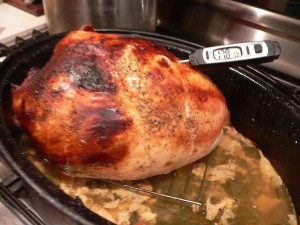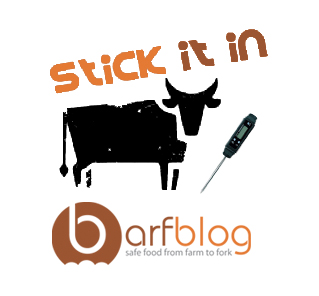One of our food safety friends from Jersey, Michele Samaya-Timm, writes:
It’s November again, and the annual countdown to Thanksgiving is upon us.
 If you haven’t thought about defrosting the turkey, it might be a good time to get this started –unless turkey popsicles are on the menu.
If you haven’t thought about defrosting the turkey, it might be a good time to get this started –unless turkey popsicles are on the menu.
Planning this step safely in the refrigerator (as recommended) is essential to food safety — experts at USDA calculate the average safe defrost time is one day for every 4 pounds of poultry. So that 20 pounder could necessitate a lead time of 5 days if the entire extended family is expected to show.
Growing up in a nice blue collar neighborhood in central New Jersey, I became accustomed to turkey prep traditions that perhaps heralded my future of improving food safety.
Every year on the Friday before Thanksgiving, my father would come home with a frozen turkey, compliments of his employer.
Usually a hefty 20-pound Tom, there was no room for it to safely sit in the modest sized Frigidaire without evicting the usual tenants of milk, eggs, condiments and leftovers. So my mother did what any good housewife in the 70’s would do…she put the frozen poultry into a scrupulously clean mop bucket, filled it with cold water, and set it in the bathtub to defrost at leisure. When bath time came for us kids, she would remove the bucket, comet the tub, and scrub us clean. This would be followed by another bout of comet scouring, and replacement of the turkey bucket in the tub. T
The process would be repeated every night until Thanksgiving morn – by which time the bird had melted into a pool of Salmonella soup.
Mom didn’t realize her turkey prep was flawed, or that she was putting her family at risk.
In the hectic myriad of preparations, most food safety errors seem like a good idea to many folks, often wrought out of desperation when a holiday — or one’s family — is looming. A few of the defrosting debacles I have heard or witnessed are examples of this lapse in knowledge or judgment.
Food safe defrosting cannot be safely accomplished in a bathtub, on the counter, or on a chair on the back porch. Likewise, car engines and room radiators are not appropriate food prep equipment. Hairdryers, clothes dryers, dishwashers and irons are appliances that should be used for their expressed purpose, and in accordance with the manufacturers’ instructions (which will not include any mention of melting a holiday bird.) Electric blankets, hot tubs and saunas are best used with non-feathered living companions. And blowtorches might just result in a flurry of unexpected guests yielding Scott Air Packs and hoses. No matter how you slice it, time, planning and good refrigeration are the best food defrosting tools.
If you are reading this on Thanksgiving morning, looking for solutions to melt a sub-zero fowl, consider cooking the bird from its frozen state. It takes a little longer (about 50% more time, according to USDA), but safety first, right? Just put out a few more appetizers and watch the game until it’s done. Or you could forego the Norman Rockwell presentation and tableside carving part of your family meal by opting for a platter of turkey legs and parts — a dissected bird will defrost quickly and will get you to a safe internal temp of 165 degrees quicker, too. Consider it handing down a tradition of healthy and food safe holidays.
Looking back, I don’t recall if the turkey-bathtub-defrost process from my childhood ever resulted in unwanted stomach effects and lengthy hours in the bathroom post- holiday. I do know that I have taken over the prep and cooking for Thanksgiving. That way, I can assure lots of handwashing, safe turkey defrosting (in the refrigerator!) and put my food thermometer collection to good use. Salmonella soup is one tradition I won’t hand down.
Ever appreciative for the dedicated folks who regularly keep our food and water safe – (and also thankful that mom doesn’t know I write about her culinary practices on the internet. )
Michele is Health Educator for Somerset County (NJ) Department of Health, currently focused on the (hopefully soon!) completion of a thesis in foodborne outbreak communications.


















